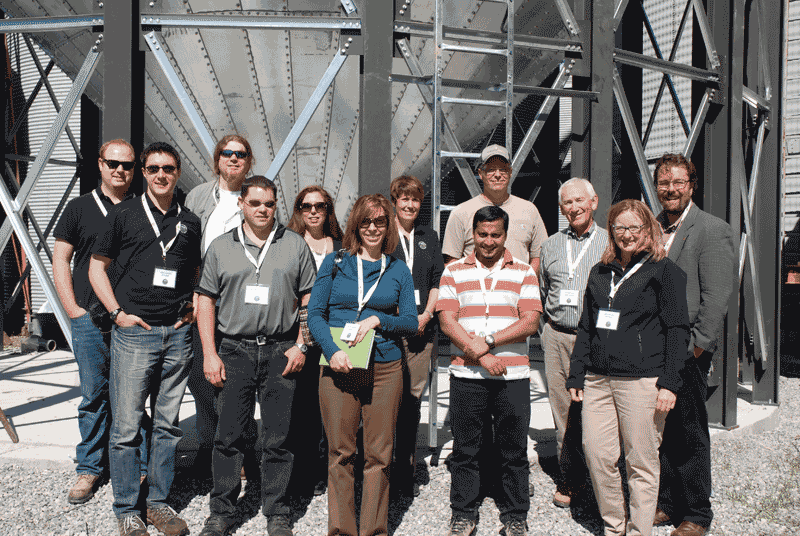Grains in Action
INDUSTRY PROGRAM
GRAIN FARMERS OF ONTARIO has expanded the reach of its popular Grains in Action program with an Industry Program.

“It’s just as important for our industry and government partners to be educated in all aspects of the grain value chain as it is for our farmer-members,” said Valerie Gilvesy, Grains in Action Program Coordinator and Member Relations for Grain Farmers of Ontario.
Grains in Action was established in 2011 to provide young agricultural leaders with the opportunity to better understand the grain sector in the province and connect with some of the end-users of the commodities they grow.
The Industry Program, held for the first time at the end of September, followed a similar itinerary to the one established in the original program to highlight end uses for Ontario corn, soybeans and wheat. It included a tour of IGPC Ethanol Inc. in Aylmer, Bunge’s oilseed processing plant in Hamilton, P&H Milling Group’s Dover Flour in Cambridge, and the Cargill Grain Terminal in Sarnia.
making connections
Dean Dias from the Canadian International Grains Institute in Winnipeg was among several participants who were particularly interested in the ethanol facility and wanted to know more about the growing fuel market. “I wanted to see the ethanol facility because not much of that is done in the western provinces,” he said.
Dias also said he was interested in gaining broader knowledge about the Ontario grain industry. “Most of the time, the work we do is based on western Canadian farming. I wanted to see another side of the country and how farming is done in this area and the different crops – its soybeans, corn and the soft wheat that is grown out here.”
One key difference of the Industry Program was a stop at Barlow Farms near Hamilton. Jeff Barlow is the sixth generation to work the farm since it was established in 1843. He currently farms 4,500 acres of corn, soybeans and wheat with his dad and seven employees. They also have their own grain elevator.
“I think this program is a great way for people to see what I do in real life compared to what their perception of farming and my job as a farm owner actually involves,” said Barlow, who is an alumni of the first Grains in Action program.
Laurie Callegari from Agricorp went on the Industry Program so that she could get a better understanding of the agricultural industry as a whole, and a farm operation in particular. “I don’t have on-farm experience. Everything I know about agriculture, that knowledge base comes from working at Agricorp,” she said. “But it’s important to gain some of that knowledge first-hand, instead of just reading the information that comes across your desk.”
new experiences
Even though they work within the agriculture industry, many people do not have direct on-farm experience. In fact, when Barlow asked the group who had been raised on a farm, or had some type of farm experience, only a couple of people raised their hand. And that, said Gilvesy, is exactly why they added this stop to the three-day tour. “The farmer is an important part of the grain value-chain and as the industry evolves there are a lot of aspects to farming that people don’t realize.”
During the tour of his workshop and elevator, Barlow highlighted some of those aspects – including his use of technology and advanced production techniques. He described the use of GPS, auto steer, and field monitoring systems as well as his strict crop rotation schedule, the use of cover crops to improve soil structure, and his variable rate fertilizer program.
“Seeing all the advancements and that there is a lot of planning that goes into play with using that technology was very interesting,” said Callegari, “particularly when he talked about not looking at the field as a whole, but dissecting it into pieces to alter the amount of fertilizer.”
The amount of on-farm technology also left an impression on Jan Westcott from Spirits Canada. “If you went to a distillery today everything is automated. It’s good to see that our partners in the business are also implementing new systems and using technology to make it better, because ultimately what that is going to do is keep costs down. And we’re customers, so everybody is interested in keeping costs down.”
Spirits Canada has been involved with Grains in Action as a presenter since the program was created and Westcott immediately recognized the benefit he would have with the opportunity to be involved in the program as a participant.
“It is critically important that we get the highest quality product coming out of the farm community and I think it helps us when we understand some of the pressures and some of the issues that the farm community is trying to deal with. You can’t get the best results if each side doesn’t understand what the other is doing, so I think it is important for all of us to have that knowledge.”
The goal of the Industry Program is to create and maintain relationships between Grain Farmers of Ontario, the participants, and the businesses and organizations involved as tour hosts. “We hope to foster conversations and build connections between different branches of agriculture,” said Gilvesy. “We are linked together in so many different ways, sometimes we need to take a moment to realize just how much we do in fact rely on each other. And if we take advantage of, and make the most of, those relationships we can ensure a strong future for farmers and the entire grain value chain.” •
For more information on the Grains in Action program for young leaders or the Industry Program, contact Valerie Gilvesy vgilvesy@gfo.ca 226-979-5581.

















